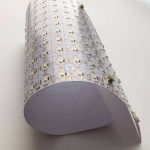Brilliant Design Starts with Lighting

Designing an aesthetically pleasing and functional interior space involves many elements—surfaces, wall coverings, flooring, furniture, appliances, and lighting. You might think lighting design is one of the last components chosen when creating a space, but did you know planning for lighting design ahead of time can be cost-effective and maximize the design’s effectiveness? When executed correctly, the best lighting design is user-friendly and mostly unnoticeable. However, when poorly planned, lighting can compromise the design of any space. Lighting is one of those rare elements we immediately notice when it doesn’t measure up—too bright or too dim can ruin the overall effect of the design. Therefore, quality lighting design should be considered an investment, not a cost.
Task, Accent, Ambient: Lighting with Purpose
Choosing the proper lighting and fixture depends on the specific application within the design, whether it’s a lobby, office, retail space, healthcare facility, or another context.
Incorporate task lighting in areas with a defined purpose, such as dressing rooms, counter spaces, or work zones.
Install accent lighting to highlight artwork, displays, and products throughout a retail store, creating drama and interest. Proper design and installation will direct the viewer’s focus toward the highlighted feature.
Ambient lighting can illuminate spaces where other light sources fail. Fixtures like downlights or linear luminaires can provide shadow-free illumination when integrated with various lighting applications.
Lighting Tip: Choose lighting based on each area’s specific function—use task lighting for focused activities, accent lighting to highlight key features, and ambient lighting to fill in where needed. A well-balanced mix enhances the look and usability of any space.

Lighting Output Measurement Impacts Design
Proper lighting enhances how products appear to the viewer and can be measured in several ways:
Correlated Color Temperature (CCT) measures the light’s appearance and refers to the warmth (amber) or coolness (blue) of a light source and is measured in degrees of Kelvin (K) on a scale from 1000 K. Generally, warm white light is anything 2000K-3000K, daylight or cool white ranges from 4100K-6500K. 3000K to 3500K, a neutral middle ground, can look cool or warm depending on the nearby furnishings.
The Color Rendering Index (CRI) assesses how different light sources influence the perceived colors of objects and surfaces. The CRI scale ranges from 1 to 100; a higher CRI value indicates that the light source renders colors more accurately. A light source with a CRI greater than 90 is ideal, while a value of 80 or higher is generally acceptable.
Lighting Tip: To make products look their best, choose lighting with the right Correlated Color Temperature (CCT) and a high Color Rendering Index (CRI). A CCT between 3000K and 3500K offers a versatile balance, while a CRI of 90+ ensures colors appear vibrant and true-to-life.
Advanced Lighting Techniques Enhance Your Design
Lighting does more than illuminate a space—it sets the tone, enhances function, and brings your design to life. Once you’ve chosen the right fixtures, you can elevate your lighting plan further with thoughtful techniques like diffusion, dimming, and smart lighting controls. These additions improve the lighting experience and increase energy efficiency and user satisfaction.
Diffusion: Softening and Balancing Light
Light can appear harsh and overly directional without proper diffusion, casting distracting shadows and reducing visual comfort. Diffusion scatters light rays to create a more pleasant and effective lighting environment by reducing glare and harsh brightness. Other benefits include eliminating dark shadows, creating a softer, more balanced atmosphere, and improving visibility and focus. Incorporating diffusion into your lighting design can enhance any space’s aesthetic and functional quality.
Lighting Controls: Personalize and Simplify
Today’s innovative lighting technologies make controlling your environment easier than ever. From mobile apps to wireless remotes, lighting control systems provide flexibility at your fingertips. Modern lighting control options include smart devices for managing multiple light sources remotely. These devices allow you to preset scenes to create tailored moods or settings for different tasks or times of day. Wireless controls can be mounted on furniture or desks, and voice command integration offers hands-free convenience. Lighting control adds an interactive and customizable element to your design, transforming lighting into an intuitive, responsive tool.
Dimming: Efficiency Meets Comfort
Dimming technology allows users to adjust light levels based on need, preference, or time of day—all while saving energy. Advantages of dimming include adjusting lighting for different activities and moods by improving comfort and ambiance. Reducing energy consumption while extending the fixture and lamp life makes dimming an efficient alternative.
Lighting Tip: While many LED fixtures are dimmable, pair them with the correct dimmer, especially for low-wattage lights, to ensure compatibility and smooth operation.

Design Without Limits
As trends in technology, sustainability, and user experience continue to converge, the opportunities for creative and efficient lighting design are more significant than ever. At Specialty Lighting, we specialize in helping clients find innovative lighting solutions tailored to their specific needs and spaces. Whether you’re designing for retail, hospitality, healthcare, or commercial environments, we’re here to illuminate your vision—beautifully and effectively.
Contact Us
